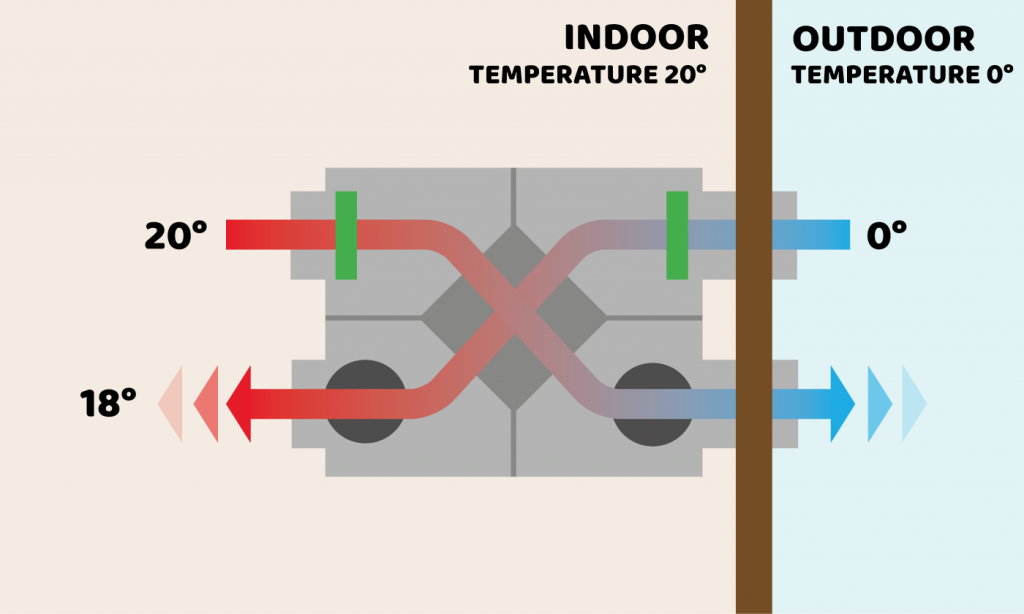Exactly How Heat Recovery Ventilation Boosts Indoor Air High Quality and Reduces Energy Costs
Heat Recovery Ventilation (HRV) systems play a necessary function in improving indoor air quality while simultaneously lowering power expenses. By successfully trading stagnant interior air with fresh exterior air, HRVs help keep suitable moisture and decrease pollutants. Furthermore, their ability to recoup heat from outward bound air minimizes the stress on home heating and cooling systems. As power costs remain to climb, understanding the complete potential of HRV systems comes to be increasingly crucial for home owners and companies alike.
Recognizing Heat Recovery Ventilation Systems

Heat recovery ventilation (HRV) systems play an essential duty in enhancing indoor air high quality, specifically in modern-day, energy-efficient buildings. These systems are developed to move warmth from the outward bound stale air to the incoming fresh air, thus reducing energy loss while maintaining ideal temperature level levels inside your home. HRVs contain a heat exchanger, fans, and ductwork, facilitating the continuous blood circulation of air. By getting rid of indoor contaminants and presenting fresh air, HRVs help to stabilize moisture degrees, protect against mold and mildew growth, and reduce allergens. The effectiveness of HRV systems lies in their capability to recuperate as much as 80% of the warm from the tired air, promoting energy conservation while guaranteeing a healthy interior atmosphere. Their assimilation is crucial in attaining lasting living methods.
The Value of Indoor Air High Quality
Indoor air quality (IAQ) is a crucial element affecting the health and wellness and wellness of residents in any environment. Poor IAQ can bring about numerous health problems, including respiratory system troubles, allergies, and fatigue. In addition, it can worsen current problems such as bronchial asthma. Elements adding to low IAQ consist of toxins from indoor resources like cleaning up agents, mold and mildew, and insufficient ventilation. Maintaining great IAQ is vital for advertising a safe and comfy living or working room. Effective approaches to enhance IAQ involve routine monitoring of air high quality, proper air flow systems, and decreasing using damaging materials inside your home. By focusing on IAQ, individuals can guarantee a healthier atmosphere that promotes performance and overall lifestyle.
Energy Efficiency Perks of HRV Systems
Lots of home owners and building managers are increasingly acknowledging the power performance benefits of warm healing ventilation (HRV) systems. By moving heat from exhausted interior air to inbound fresh air, HRV systems markedly minimize the energy required for heating & cooling. This process reduces reliance on conventional a/c systems, bring about reduced power expenses. Furthermore, HRVs assist preserve a balanced indoor climate, protecting against extreme heating or cooling down needs. The capability to recuperate as much as 90% of the warm from outbound air also supports sustainability initiatives by lowering total power usage. As a result, HRV systems contribute not just to set you back savings but likewise to a minimized carbon footprint, aligning with the expanding focus on energy-efficient structure techniques.
Installation and Upkeep Considerations
The reliable application visit here of warmth healing ventilation (HRV) systems calls for cautious factor to consider of setup and maintenance factors to guarantee peak efficiency. Appropriate positioning of the HRV system is crucial, as it review ought to be installed in a location that maximizes airflow while reducing sound interruption. In addition, ductwork needs to be appropriately sized and protected to avoid power loss. Regular upkeep, including filter replacement and system cleansing, is vital to protect ideal functionality and interior air top quality. Owners must establish a routine upkeep timetable to determine and attend to prospective concerns before they rise. Collaboration with seasoned professionals during both setup and upkeep phases can enhance the durability and performance of HRV systems, ultimately resulting in far better indoor settings and minimized energy expenses.
Real-World Applications and Success Stories
Checking out real-world applications of warmth recuperation ventilation (HRV) systems reveals their considerable effect on interior air top quality and power performance throughout various settings. In residential buildings, property owners have reported enhanced air top quality, causing less allergic reactions and respiratory system concerns. Schools applying HRV systems have actually kept in mind improved student concentration and reduced absence because of better ventilation. Business buildings, such as workplaces and retail spaces, have experienced lower energy prices and go to this web-site boosted worker efficiency. For circumstances, a corporate workplace in a warm climate attained a 30% decrease in energy costs after setting up an HRV system. These success stories show that HRV modern technology not just adds to healthier settings however likewise provides substantial financial benefits, making it an important investment for various fields.
Often Asked Questions
Can HRV Equipments Minimize Allergens in Indoor Air?
The performance of HRV systems in lowering indoor irritants mostly rests on their capacity to filter and exchange air. HRV Heat Recovery Ventilation. By constantly replacing stagnant air, these systems can substantially reduce allergen degrees throughout indoor atmospheres

Exactly How Does Humidity Affect HRV System Efficiency?
Moisture significantly influences HRV system performance; high degrees can bring about condensation, minimizing effectiveness, while reduced moisture may boost air exchange. Balancing humidity is crucial for suitable operation and maintaining interior air quality.
Are HRV Equipments Noisy During Procedure?
HRV systems can create differing noise levels throughout procedure, depending upon their style and setup. Some systems run quietly, while others might produce recognizable noise, especially at higher air movement setups or when improperly maintained.
What Is the Typical Lifespan of an HRV System?

Can HRV Systems Be Utilized in All Environments?
HRV systems can be made use of in different environments, however their performance might differ - HRV Heat Recovery Ventilation. In extreme temperatures, adjustments or extra systems could be necessary to assure suitable performance and convenience while preserving indoor air quality